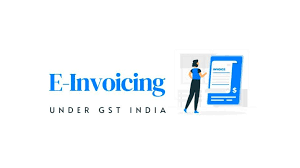E-invoicing of GST (Goods and Services Tax) is a digital invoicing system introduced by the Government of India to streamline and automate the invoice generation and reporting process. It aims to enhance tax compliance, reduce tax evasion, and improve overall efficiency in the tax system. Here is a complete guide to understanding e-invoicing of GST:
What is e-invoicing?
E-invoicing is the process of electronically generating and reporting invoices directly from the billing software to the GST portal. It involves the use of standardized invoice formats and digital signatures to ensure authenticity and integrity.

Applicability:
E-invoicing is mandatory for businesses with a certain turnover threshold. Initially, it was applicable to businesses with an annual aggregate turnover exceeding Rs. 100 crores. However, the threshold has been gradually reduced to include more businesses. It is essential to check the latest turnover threshold criteria as per the notifications issued by the government.
Generating e-invoices:
To generate e-invoices, businesses need to adopt an accounting or billing software that is compatible with the e-invoicing system. The software must be capable of generating invoices in the specified format, including all the mandatory fields and digital signatures.
Invoice Registration Portal (IRP):
The government has designated Invoice Registration Portal (IRP) as the central hub for e-invoicing. The IRP validates and registers the invoices generated by businesses and issues a unique Invoice Reference Number (IRN) along with a digitally signed e-invoice. The IRP also generates a QR code containing essential invoice details.
E-way bill integration:
E-invoicing and e-way bill systems are integrated to streamline the movement of goods. Once an e-invoice is generated and the IRN is obtained, the e-way bill can be generated automatically, reducing duplication of data entry and improving efficiency.
Reporting and compliance:
E-invoices generated through the accounting or billing software are automatically reported to the GST portal in real-time. This eliminates the need for manual data entry and reduces the chances of errors. Businesses need to ensure timely and accurate reporting of e-invoices to maintain compliance with GST regulations.
Benefits of e-invoicing:
Reduced errors and data discrepancies in invoices.
Improved efficiency in the tax system.
Faster availability of input tax credit.
Reduction in tax evasion and fraud.
Simplified reporting and compliance procedures.
Documentation and record-keeping:
Businesses must maintain proper documentation of e-invoices and related records for audit and compliance purposes. These records should be preserved as per the statutory requirements.
It is important to note that the e-invoicing requirements and guidelines are subject to change based on government notifications. Businesses should regularly refer to official sources and consult professionals to stay updated on the latest regulations and comply with e-invoicing requirements effectively.